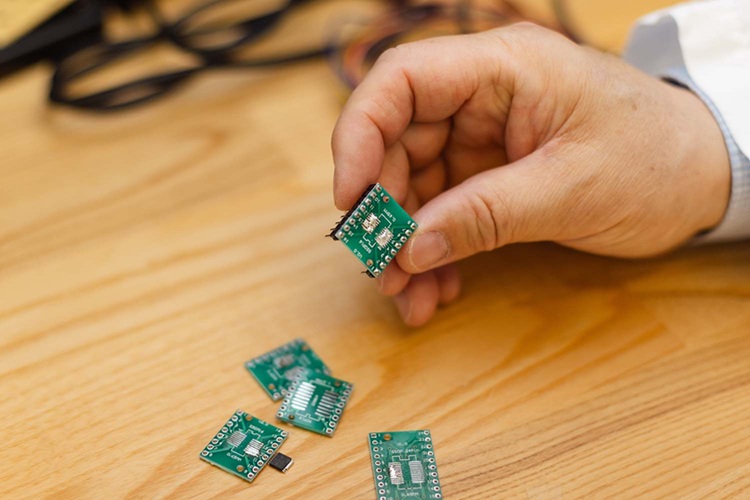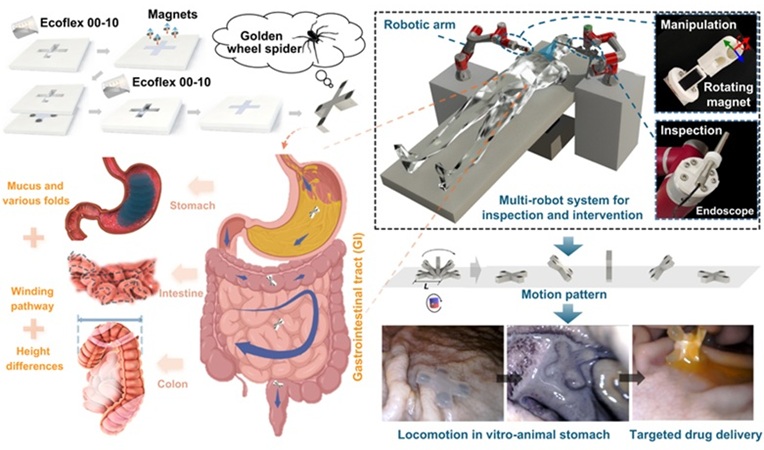Electronic Pill Helps Combat Obesity Eating Disorders
|
By HospiMedica International staff writers Posted on 06 May 2015 |

Image: The prototype Melcap capsule (Photo courtesy of Melcap).
A prototype electronic capsule delivers electrical stimulation to the muscles of the stomach wall, giving the patient a feeling of satiety and reducing their urge for food intake.
The MelCap system is comprised of three main parts; a remotely controlled capsule adapted for ingestion or placement into the gastrointestinal tract (GT); a remote control device or smartphone for controlling and sharing information with the capsule; and a magnetic coupling system for fixing the capsule within the GI tract of the patient. The capsule, the size of a large pill, is first swallowed by the patient. Upon arrival into the stomach, it absorbs stomach fluids, increasing its size, enabling it to remain in place and operate continuously.
Once in place, the magnetic coupling system is used to position it in the specific spot selected within the stomach, be it near the lower esophagus sphincter (LES) or in proximity to the vagus nerve. The pill unfurls a mesh filled with inflated particles and the wireless device is then used to activate the pill. When it receives the signal, the pill delivers a series of electrical pulses to stimulate the lining of the stomach. Depending on the pill’s location, different effects can be achieved to tailor the therapy to individual patient needs.
These could include, for example, gastric electrical stimulation (GES), LES muscle simulation, or vagus nerve blocking. The capsule continues to deliver electrical stimulation for up to 21 days, continuously monitored and controlled remotely by the wireless device. When exhausted, some of the biologic components are absorbed, while the electronic components are expelled from the system. The MelCap system is a product of Melcap (Ramat Gan, Israel).
Related Links:
Melcap
The MelCap system is comprised of three main parts; a remotely controlled capsule adapted for ingestion or placement into the gastrointestinal tract (GT); a remote control device or smartphone for controlling and sharing information with the capsule; and a magnetic coupling system for fixing the capsule within the GI tract of the patient. The capsule, the size of a large pill, is first swallowed by the patient. Upon arrival into the stomach, it absorbs stomach fluids, increasing its size, enabling it to remain in place and operate continuously.
Once in place, the magnetic coupling system is used to position it in the specific spot selected within the stomach, be it near the lower esophagus sphincter (LES) or in proximity to the vagus nerve. The pill unfurls a mesh filled with inflated particles and the wireless device is then used to activate the pill. When it receives the signal, the pill delivers a series of electrical pulses to stimulate the lining of the stomach. Depending on the pill’s location, different effects can be achieved to tailor the therapy to individual patient needs.
These could include, for example, gastric electrical stimulation (GES), LES muscle simulation, or vagus nerve blocking. The capsule continues to deliver electrical stimulation for up to 21 days, continuously monitored and controlled remotely by the wireless device. When exhausted, some of the biologic components are absorbed, while the electronic components are expelled from the system. The MelCap system is a product of Melcap (Ramat Gan, Israel).
Related Links:
Melcap
Latest Critical Care News
- Low-Cost Medical Device Stops Postpartum Hemorrhages
- Non-Invasive Wearable Sensor Detects Sweat Biomarker in Low-Perspiration Conditions
- New Autoinjector Could Transform Trauma Care in Severe Bleeding Emergencies
- Portable Light-Based Brain Monitor Improves Dementia Diagnosis
- New Ultrasound Technique Enables Safer Vein Access in Critically Ill Patient
- CVD Risk Prediction Tool Could Guide Statin Therapy
- Wearables Could Revolutionize Pregnancy Monitoring and Detect Abnormalities
- AI Model Identifies AF Patients Requiring Blood Thinners to Prevent Stroke
- Soft Robot Intubation Device Could Save Lives
- Bee-Sting Inspired Wearable Microneedles to Revolutionize Drug Delivery
- Wearable Smart Patch Runs Tests Using Sweat Instead of Blood
- AI Improves Prediction of CKD Progression to End Stage Renal Disease
- First-Of-Its-Kind Online Tool to Revolutionize Treatment of High Blood Pressure
- Temperature-Sensing Patch Enables Early Breast Cancer Detection
- AI Stethoscope Detects Three Heart Conditions In 15 Seconds
- AI Powered Mini-Camera Predicts Recurrent Heart Attack
Channels
Surgical Techniques
view channel
Micro Imaging Device Paired with Endoscope Spots Cancers at Earlier Stage
Digestive system cancers are among the most common cancers, with hundreds of thousands of new cases and deaths reported annually in the United States. Standard endoscopy, the main diagnostic method for... Read more
Spider-Inspired Magnetic Soft Robots to Perform Minimally Invasive GI Tract Procedures
The gastrointestinal (GI) tract is vital for digestion, nutrient absorption, and waste elimination, but it is also prone to cancers and other serious conditions. Standard endoscopy is widely used for diagnosis... Read more
AI Spine Model Could Reduce Surgical Risks
Nearly 3 in 10 adults in the United States have experienced lower back pain in any three months, making it the most common musculoskeletal pain. Back pain is one of the leading causes of disability worldwide,... Read more
Novel Method Uses Interstitial Fluid Flow to Predict Where Brain Tumor Can Grow Next
Glioblastoma is one of the most aggressive brain cancers, with patients surviving on average only 15 months after diagnosis. Surgery and radiation can temporarily control the tumor, but the disease almost... Read morePatient Care
view channel
Revolutionary Automatic IV-Line Flushing Device to Enhance Infusion Care
More than 80% of in-hospital patients receive intravenous (IV) therapy. Every dose of IV medicine delivered in a small volume (<250 mL) infusion bag should be followed by subsequent flushing to ensure... Read more
VR Training Tool Combats Contamination of Portable Medical Equipment
Healthcare-associated infections (HAIs) impact one in every 31 patients, cause nearly 100,000 deaths each year, and cost USD 28.4 billion in direct medical expenses. Notably, up to 75% of these infections... Read more
Portable Biosensor Platform to Reduce Hospital-Acquired Infections
Approximately 4 million patients in the European Union acquire healthcare-associated infections (HAIs) or nosocomial infections each year, with around 37,000 deaths directly resulting from these infections,... Read moreFirst-Of-Its-Kind Portable Germicidal Light Technology Disinfects High-Touch Clinical Surfaces in Seconds
Reducing healthcare-acquired infections (HAIs) remains a pressing issue within global healthcare systems. In the United States alone, 1.7 million patients contract HAIs annually, leading to approximately... Read moreHealth IT
view channel
Printable Molecule-Selective Nanoparticles Enable Mass Production of Wearable Biosensors
The future of medicine is likely to focus on the personalization of healthcare—understanding exactly what an individual requires and delivering the appropriate combination of nutrients, metabolites, and... Read moreBusiness
view channel
Philips and Masimo Partner to Advance Patient Monitoring Measurement Technologies
Royal Philips (Amsterdam, Netherlands) and Masimo (Irvine, California, USA) have renewed their multi-year strategic collaboration, combining Philips’ expertise in patient monitoring with Masimo’s noninvasive... Read more
B. Braun Acquires Digital Microsurgery Company True Digital Surgery
The high-end microsurgery market in neurosurgery, spine, and ENT is undergoing a significant transformation. Traditional analog microscopes are giving way to digital exoscopes, which provide improved visualization,... Read more
CMEF 2025 to Promote Holistic and High-Quality Development of Medical and Health Industry
The 92nd China International Medical Equipment Fair (CMEF 2025) Autumn Exhibition is scheduled to be held from September 26 to 29 at the China Import and Export Fair Complex (Canton Fair Complex) in Guangzhou.... Read more












